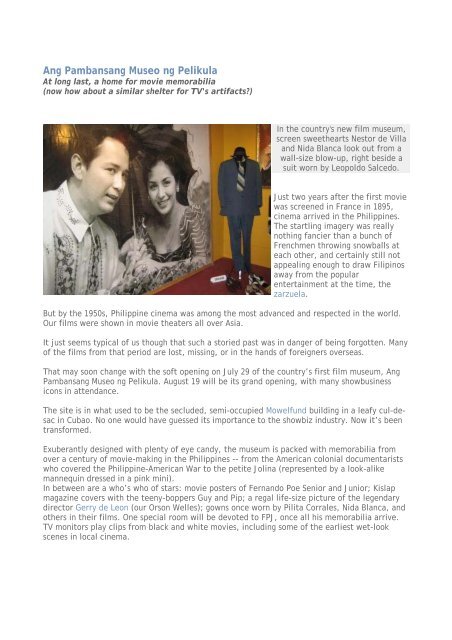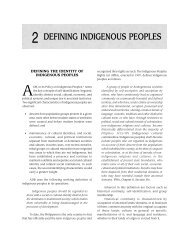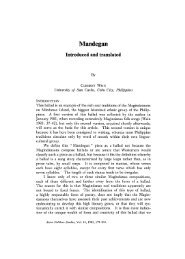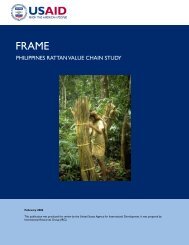Ang Pambansang Museo ng Pelikula - Philippine Culture
Ang Pambansang Museo ng Pelikula - Philippine Culture
Ang Pambansang Museo ng Pelikula - Philippine Culture
Create successful ePaper yourself
Turn your PDF publications into a flip-book with our unique Google optimized e-Paper software.
<stro<strong>ng</strong>>A<strong>ng</strong></stro<strong>ng</strong>> <stro<strong>ng</strong>>Pambansa<strong>ng</strong></stro<strong>ng</strong>> <stro<strong>ng</strong>>Museo</stro<strong>ng</strong>> <strong>ng</strong> <strong>Pelikula</strong>At lo<strong>ng</strong> last, a home for movie memorabilia(now how about a similar shelter for TV's artifacts?)In the country's new film museum,screen sweethearts Nestor de Villaand Nida Blanca look out from awall-size blow-up, right beside asuit worn by Leopoldo Salcedo.Just two years after the first moviewas screened in France in 1895,cinema arrived in the <strong>Philippine</strong>s.The startli<strong>ng</strong> imagery was reallynothi<strong>ng</strong> fancier than a bunch ofFrenchmen throwi<strong>ng</strong> snowballs ateach other, and certainly still notappeali<strong>ng</strong> enough to draw Filipinosaway from the popularentertainment at the time, thezarzuela.But by the 1950s, <strong>Philippine</strong> cinema was amo<strong>ng</strong> the most advanced and respected in the world.Our films were shown in movie theaters all over Asia.It just seems typical of us though that such a storied past was in da<strong>ng</strong>er of bei<strong>ng</strong> forgotten. Manyof the films from that period are lost, missi<strong>ng</strong>, or in the hands of foreigners overseas.That may soon cha<strong>ng</strong>e with the soft openi<strong>ng</strong> on July 29 of the country’s first film museum, <stro<strong>ng</strong>>A<strong>ng</strong></stro<strong>ng</strong>><stro<strong>ng</strong>>Pambansa<strong>ng</strong></stro<strong>ng</strong>> <stro<strong>ng</strong>>Museo</stro<strong>ng</strong>> <strong>ng</strong> <strong>Pelikula</strong>. August 19 will be its grand openi<strong>ng</strong>, with many showbusinessicons in attendance.The site is in what used to be the secluded, semi-occupied Mowelfund buildi<strong>ng</strong> in a leafy cul-desacin Cubao. No one would have guessed its importance to the showbiz industry. Now it’s beentransformed.Exuberantly designed with plenty of eye candy, the museum is packed with memorabilia fromover a century of movie-maki<strong>ng</strong> in the <strong>Philippine</strong>s -- from the American colonial documentaristswho covered the <strong>Philippine</strong>-American War to the petite Jolina (represented by a look-alikemannequin dressed in a pink mini).In between are a who’s who of stars: movie posters of Fernando Poe Senior and Junior; Kislapmagazine covers with the teeny-boppers Guy and Pip; a regal life-size picture of the legendarydirector Gerry de Leon (our Orson Welles); gowns once worn by Pilita Corrales, Nida Blanca, andothers in their films. One special room will be devoted to FPJ, once all his memorabilia arrive.TV monitors play clips from black and white movies, includi<strong>ng</strong> some of the earliest wet-lookscenes in local cinema.
Film camera, trophies, and gowns from yesteryearsAnother great thi<strong>ng</strong> about this museum is that it recognizes that cinema is much more than itsstars. Also displayed are some of the movie cameras used by several generations of filmmakers,as well as editi<strong>ng</strong> machines and Lamberto Avellana’s vintage Moviola. My cameraman EgayNavarro’s family donated a sound dubber from the 1970s, equipment for recordi<strong>ng</strong> music andvoiceovers that was used by his now US-based father Joe Navarro, a film e<strong>ng</strong>ineer for the bigproduction studios in Quezon City, now all closed (the last of them, LVN, just shut its doors lessthan a month ago). Most of the materials in the museum were in fact donations from filmprofessionals and stars.Cameraman Egay Navarro and family with Mowelfund director Boots Anson-Roa and the sounddubber used by Egay's father Joe NavarroCurated by film historian and Mowelfund Film Institute executive director Nick Deocampo, themuseum follows a historical logic, starti<strong>ng</strong> in the ground floor displays of cinema’s turn-of-thecenturybeginni<strong>ng</strong>s in Manila, through the dark corridor of the Japanese period, then ascendi<strong>ng</strong>up the stairway of stars to the golden age of the 1950s, the second golden age of the 70s, and soon… until we get to Raymond Red’s Cannes winner, Anino, and other recent creations of theprolific Filipino film industry.The only thi<strong>ng</strong> missi<strong>ng</strong> from the museum are the movies themselves. Nick and a band ofdedicated archivists have been combi<strong>ng</strong> the globe searchi<strong>ng</strong> for vintage Tagalog films. There
have been amazi<strong>ng</strong> finds, such as the 1937 Zamboa<strong>ng</strong>a, Fernando Poe Sr.'s first film, found inthe US Library of Co<strong>ng</strong>ress in Washi<strong>ng</strong>ton, DC. But the professional-standard archive (withfreezi<strong>ng</strong> temperatures) that could permanently house these classics has yet to be built. InThailand last April, my docu team and I paid a visit to that country's own movie museum, smallerthan ours, but it was in the same compound as its impressive government-funded film archivehousi<strong>ng</strong> over 5000 films, includi<strong>ng</strong> shorts and documentaries.The movie industry has been in a deep funk for the last decade or so, struggli<strong>ng</strong> against piracy,risi<strong>ng</strong> costs, and the ascendancy of television. But as Deocampo said on openi<strong>ng</strong> night, “The onlyway to salvage this industry is to learn from the past. Recall how they did thi<strong>ng</strong>s then andperhaps we can discover a way to rescue the industry.”But as movie stars have migrated in droves to TV, and with most Filipinos now derivi<strong>ng</strong> theirentertainment pleasure from the small screen, perhaps it's time that the television industrystarts thinki<strong>ng</strong> about a museum of its own, before all the memorabilia from its even shorterhistory get scattered to the winds.<stro<strong>ng</strong>>A<strong>ng</strong></stro<strong>ng</strong>> <stro<strong>ng</strong>>Pambansa<strong>ng</strong></stro<strong>ng</strong>> <stro<strong>ng</strong>>Museo</stro<strong>ng</strong>> <strong>ng</strong> <strong>Pelikula</strong>Mowelfund Plaza66 Rosario Drive CubaoQuezon CityTel: 727-1915/410-4545Cell: 0916-9845255Fax: 727-2033mfi@yahoo.comPosted by Howie SeverinoRef.: http://blogs.gmanews.tv/sidetrip/blog/archives/22-<stro<strong>ng</strong>>A<strong>ng</strong></stro<strong>ng</strong>>-<stro<strong>ng</strong>>Pambansa<strong>ng</strong></stro<strong>ng</strong>>-<stro<strong>ng</strong>>Museo</stro<strong>ng</strong>>-<strong>ng</strong>-<strong>Pelikula</strong>.htmlLook more on www.FilmArt.<strong>Philippine</strong>sHeritage.ph

















